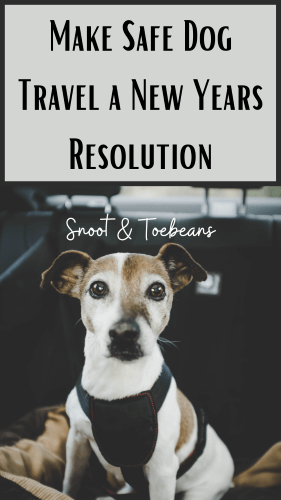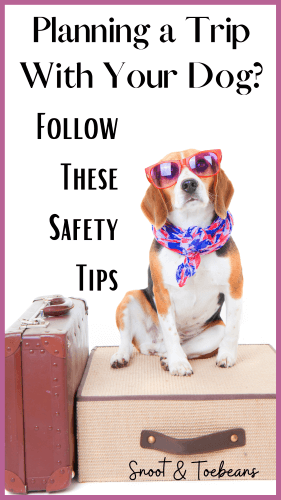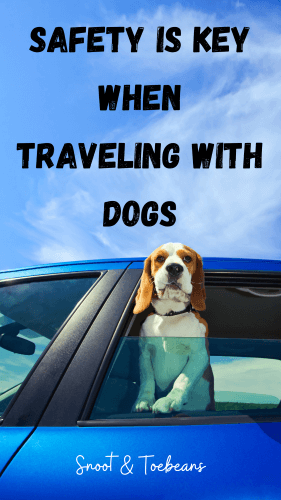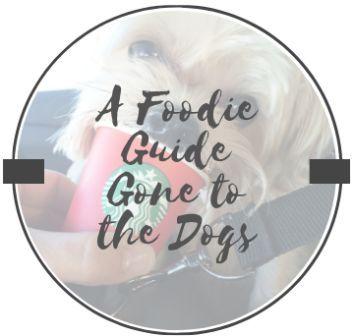Disclosure: My dog blog is supported by dog parents just like you. I only recommend products that I would use on my dogs. All opinions expressed here are my own. I sometimes earn a small affiliate commission, at no extra cost to you, when you click through the affiliate link and purchase something. You can read more about my affiliate policy here.
Happy New Year 2022! January 2nd is National Pet Travel Safety Day. Therefore, you can add “safe dog travel” to your resolutions on this day.
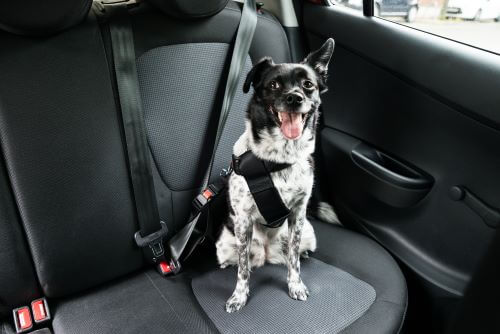
Above all, safe dog travel should be a priority whether going on vacation or going to the vet. Plus, many dogs love to travel, especially by car. However, any kind of travel can be stressful for you and your dog, if you aren’t prepared.
Therefore, by planning carefully, you can make your journey safe and comfortable for you and your dog. For instance, safe dog travel requires you to take some steps to prepare for your dog’s needs.
Most importantly, safe dog travel requires a calm dog parent from the get go. If you are calm, your dog will be calm. Furthermore, dogs pick up on our stress. So, if you’re nervous and uptight, your dog may be, too.
Therefore, stay calm and carry on in your travel preparation with our safe dog travel tips…
Safe Dog Travel Includes Health Checks
Are you planning a long distance, overnight trip? If so, then your dog needs a clean bill of health from the vet. In other words, your dog needs to be healthy enough to travel.
So, take your dog to the vet for a checkup before going on an extended trip. You will want your vet to ensure your dog’s mental and physical shape is good for travel.
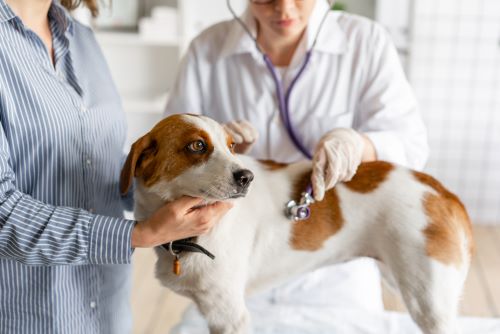
In addition, travel often means your dog will come in contact with other animals. So, be sure to ask your vet about proper vaccinations. Plus, make sure all vaccinations are up to date and carry those shot records with you.
For instance, hotels and other lodging establishments may require showing proof of vaccinations at check-in. In addition, health certifications are required for airline travel.
However, a visit to the vet isn’t the only health preparation that needs to happen when traveling. For example, plan for an emergency, and travel with a dog first aid kit.
In addition, research emergency pet hospitals and local veterinarians in the area you will travel to. Print out the information or add it to your smartphone for easy access.
Lastly, be sure to check your dog’s health en route to and once arriving at your destination. Plus be sure to have plenty of water on hand to prevent dehydration and don’t forget any medications.
Safe Dog Travel Includes Proper Identification
There’s always the chance you and your dog could be separated while traveling. Therefore, it is important that your dog is wearing a collar with an identification tag.
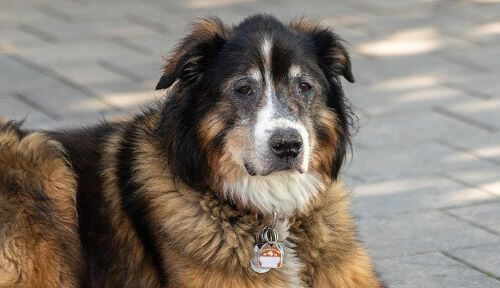
Furthermore, the tag should include your dog’s name, your name, and a cell phone number. Plus, a rabies tag will ensure your dog is safe to be around when someone finds her or him.
Most importantly, an identification tag increases your chance to reunite with your dog. In addition, consider a permanent form of identification, such as a microchip. You can check out information at AKC Reunite.
Another idea is to have a recent photo of your dog with you. These days it is common for people to have photos of their dog on their phone. However, you might consider printing a few photos to hand out in the event your dog is lost.
Safe Dog Travel Includes a Crate
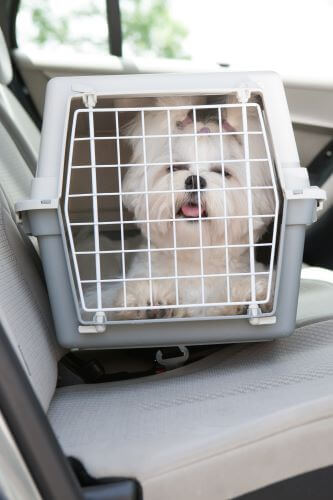
There are several reasons why a crate is important for your dog’s safety when traveling. Firstly, it’s a great way to keep your dog safe when traveling by car. Secondly, it is actually required for airline travel.
Thirdly, a crate keeps your dog safely contained in a hotel room or at your host’s home. There are a few features to consider when purchasing a crate…
- Large enough to allow your dog to stand, turn, and lie down.
- Ventilation on opposite sides with knobs or exterior rims to prevent blocked airflow.
- Leak-proof base covered with absorbent material and no interior protrusions.
- Strong, with handles and grips.
- Label that states “Live Animal”; arrows showing upright position; and space for owner’s name, address, and phone number.
Furthermore, place a comfortable mat inside the crate for your dog with a favorite toy and water bottle.
Safe Dog Travel With Lodging
When it comes to lodging while planning your trip, find out in advance who allows dogs. For instance, many hotels, motels, and short term rentals don’t allow pets. Therefore, you will need to do some research. Plus, some of the places that allow dogs have size restrictions.
If your dog is allowed to stay, make a sweep of the premises ensuring it’s safe for exploring. For example, put the electrical cords out of reach. Furthermore, make sure the previous occupants didn’t leave anything behind that could be potentially harmful to your dog.
In addition, make sure you “doggy-proof” your vacation space before you let your dog have free roam. Be considerate of other guests and staff by keeping your dog as quiet as possible.
Your dog might have anxiety staying in a strange place, so don’t leave him or her unattended. Not to mention, they might bark uncontrollably and destroy property that could cause them injury.

Traveling by Land with Your Dog
Out of all the ways to travel, car travel probably puts the least amount of stress on dogs. However, there are several safety precautions that still need to be accounted for.
Car Travel
Most importantly, consider a dog seat belt, dog car seat, or dog carrier to keep your dog safe. We buckle up our kids for safety, so why not buckle up our furry kids for safety? Over 400,000 people are involved in car accidents each year due to distractions. Furthermore, the distraction is from an unrestrained dog.
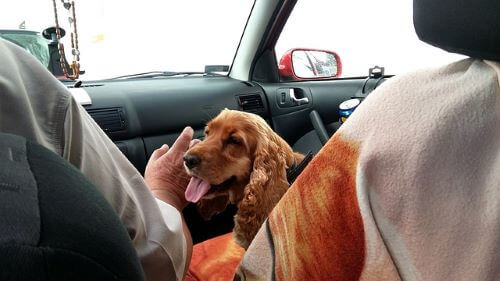
Plus, an unrestrained dog is at risk of injury or even death. For example, in a car wreck an unrestrained dog becomes a dangerous projectile thrown by the force. Therefore, they likely will injure themselves and/or others in the car.
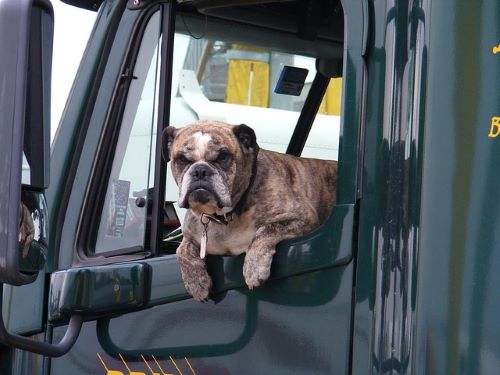
Furthermore, a dog sitting in the front seat could be seriously injured or killed by deployed airbags. So if your small dog rides in the front seat, make sure they are in a booster seat. For instance, you don’t want their weight to activate the passenger airbags.
In addition, it is safer for your dog’s entire body to be inside the car even if unrestrained. Here is a list of the dangers when a dog is hanging out of a car window…
- A dog could lean too far out of the window either in excitement or by accident and fall out.
- Suddenly braking or a car crash could project your dog out of the window.
- Small bugs and pavement gravel are projecting fast and could become lodged in an eye.
- Squirrels and other animals cause excitement and a dog could suddenly jump from a car.
- Passing cars could sideswipe, crushing a dog between the two cars.
So instead, just crack a window. The fresh air and scents will still provide enrichment.
Bus and Train Travel
If you are going to travel by an Amtrak train and want to take your dog along, then you are in luck. However, you are only in luck if your dog is under 20 pounds. Plus, there is a $25 fee and your dog must ride in a carrier under your seat. Therefore, scroll back up and read our tips on carriers to keep your dog safe on a train.
In addition, dogs are not allowed on Greyhound and other interstate bus companies. However, service dogs are permitted. Furthermore, you will have to check with local rail and bus companies for their policies.
Traveling by Air with Your Dog
When it comes to air travel with your dog, there are several airline regulations for your dog’s safety. In addition, each airline has different ones. Therefore, you will need to prepare by checking with the airline you plan to use. However, here are a few general regulations…
- Your dog should be at least 8 weeks old and weaned.
- Certification of health must be provided to the airline no more than 10 days before travel.
- Rabies and vaccination certificates are also required.
- You must make reservations for your dog.
- Dogs are accepted on a first-come, first-serve basis on each flight.
- There are restrictions on the number of animals permitted on each flight.
- A dog must weigh less than 20 pounds to ride in the cabin, however each airline is different.
- Your dog must be in a crate or carrier while in flight. However, each airline has its own variations on regulations and services with crates or carriers.
To keep your dog calm during air travel, you might consider tranquilizing your dog for the trip. Furthermore, it is best to ask your veterinarian what would be best to use or if you should.
In addition, you might want to rethink a trip if your dog is too big to fly in the cabin with you. When dogs have to fly in cargo, it’s extremely stressful for them and, for some, very dangerous.

Now This Is Something To Bark About!!
Traveling by Water with Your Dog
When it comes to water travel with your dogs, there are a few ways to do so. For instance, you can travel with your dog by personal boats, ferry boats, or cruise ships.
Traveling by water can be a rewarding experience for you and your dog. However, make sure you’re prepared. The following tips can help you keep your dog safe and happy while out on the water…
- Call ahead to make sure the marina or park is dog friendly.
- Provide a ramp for your dog to easily get on and off the boat. If you don’t have a ramp, then plan to carry your dog on and off the boat.
- Provide a shaded area for your dog, because excessive exposure to the sun can cause heatstroke.
- Sunscreen will also help keep your dog from getting sunburned. Your veterinarian can recommend a non-toxic, non-skin irritating sunscreen for pets.
- Provide non-slip bathroom rugs to help keep your dog from sliding on the wet boat. Plus, this will help keep them from burning their paws.
- Consider a carrier, or a harness with leash to prevent your dog from jumping or falling overboard. Plus, have a plan in place just in case your dog does go overboard.
- Keep a dog first aid kit on board. Furthermore, check with your vet to see what your dog can take for seasickness. Plus, keep plenty of drinking water available.
- Dogs should wear a proper-fitting flotation device at all times to keep them safe. This goes even if they know how to swim.
Importance of Life Jackets for Your Dog
There are no regulations regarding life jackets for dogs. However, a life jacket can help keep your dog safe around any body of water. They are designed to keep a dog afloat in a horizontal, swimming position.
Furthermore, a dog life jacket serves as a retrieval device in the event a dog falls overboard. Lifejackets need to be bright in color to make it easier to see dogs in the water. Plus, they need to fit securely and have lifting handles to make retrieving safer and easier.
Not all dogs can swim and those that can aren’t all great swimmers. Here are a few other reasons why a dog should wear a life jacket around water…
- Water or weather conditions can cause problems, even for a dog that is typically a strong swimmer.
- Any dog can get fatigued or disoriented, especially older dogs can tire easily.
- Dogs with low body fat can have trouble when exposed to water for long periods.
- Health issues, such as hip or joint problems, can also make swimming difficult for some dogs.

In Conclusion
Remember that not all dogs enjoy traveling. Therefore, safe dog travel for your dog may mean leaving him or her home with a dog sitter.
You might like to read the following posts on our blog:
- Road Tripping With Your Dog – 19 Tips to Follow
- Hiking with Your Dog on National Take a Hike Day
- Dog First Aid Kit – a DIY With the Essentials
Do you take your dog with you when you travel or leave them behind? Let us know in the comments below.
Do you have other safe dog travel tips to add to ours? We would love to read about them in the comments below.
You can save this post to your Pinterest account by using one of the following images to pin.
